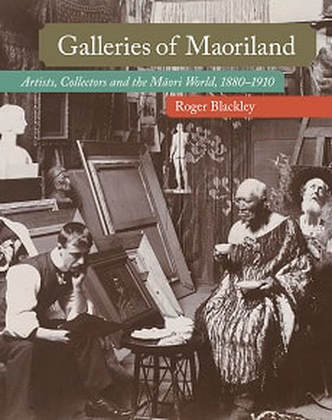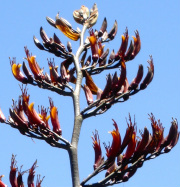
by Roger Blackley
The dates are of particular significance, as this is the period that began with the common assumption by Pākehā that Māori were a dying race, and ends at a time when the evidence of Māori ‘renaissance’ showed that the assumption was wrong. In that thirty year period the term ‘Maoriland’ for Aotearoa/New Zealand was common currency amongst Pākehā as they attempted to establish a unique identity for themselves as white New Zealanders, in part by appropriating, and frequently misinterpreting, certain aspects of Māori culture to this purpose. Much of the art of this period reflects this; but, as the author points out, the process was one in which Māori themselves were closely involved in a number of ways.
The artists Lindauer and Goldie were active during this time, and both are best known for their portraits of Māori individuals. We learn that often the Lindauer portraits were commissioned by the subjects themselves, and that many of these are still in the hands of descendants and are greatly revered. This is just one way in which the author demonstrates that Māori were at times much more than simply the subjects of European artists, but were intimately involved in decisions regarding the way they and their culture were depicted. Thus the subjects of many of the Lindauer portraits have clearly chosen their own ‘modern’ attire, distinctly different from Goldie’s subjects who are mostly dressed in traditional cloaks and holding artefacts that display them as examples of the romanticised, noble but dying race of the European imagination.
The book covers the often devious and culturally insensitive, and at times frankly fraudulent, methods of collecting and using Māori artefacts (termed ‘curios’ in the European world, but often sacred taonga, the use and display of which should have been subject to tikanga). The prime example here was probably Walter Buller, who used his position as a lawyer in the Native Land Court (and his close association with Lindauer) to build a large personal collection of art and artefacts.
We also learn of the casual racism in some of the ‘art’ of the period, and in particular that of the influential illustrator Trevor Lloyd. This section of the book is accompanied by illustrations that must surely, and necessarily, make us cringe. As something of a balance to this we are reminded that in truth Māori artists of the period were producing works that displayed a universal beauty and an intensity of drama that was probably unequalled by anything European artists in New Zealand were producing. Undeniably among the finest examples of art in the book are the panels produced by Tene Waitere for Rauru, the specially commissioned wharenui that was fraudulently spirited out of the country to finally end up in Germany. They are breath-taking, and show that Māori art was not just alive and well, but was adapting and developing in astonishing ways.
Some attention is given to literature and music, but the major emphasis is on the visual arts, and for those for whom this is their major interest the book is a treasure trove. To take just one example with a fascinating history, there is Lindauer’s portrait of Terewai Horomona (given the title ‘The Maori Poi Dancer’) that so enchanted the Prince of Wales when he saw it in 1886 at a London Exhibition that he proclaimed it one of the most beautiful pictures he had ever seen. When Buller (who had arranged for its hanging in the New Zealand Court at the Exhibition) heard of this comment, he immediately despatched it to the Prince as a gift, along with a five thousand pound contribution to the Prince’s Imperial Institute. His reward was to be created a KCMG.
This is a stunning book visually, and the text is also excellent – and accessible. The arguments are sometimes provocative, but always meticulously referenced and scholarly. It takes us along fascinating if sometimes disturbing pathways towards a greater understanding of what it meant to be colonised or coloniser, and reminds us of how fortunate we are that Māori culture plays such a large part today in determining our national cultural identity.
Author: Roger Blackley
Publisher: Auckland University Press
ISBN: 9781869409357
RRP: $75
Available: bookshops

 RSS Feed
RSS Feed
